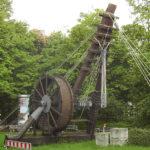The Roman Empire invested a lot of time, effort and money developing new cranes for the construction of their buildings, bridges and especially aqueducts. They took the Greek's crane as a model and improved it.
In fact, the simplest Roman crane was the Tripastos. It consisted of a single beam jib, a lathe, a rope, and a block containing three pulleys. By maintaining a multiplication ratio of 3 to 1, a single crane operator could raise 300 lbs.

A more advanced type of crane was the Pentaspastos which had five pulleys. Moreover and even more sophisticated than the Pentaspastos, was the Polyspastos, which had 15 pulleys and up to four masts with a ratio of 60 to 1.
Ereaders
The Polyspastos, indeed, had four operators per side of the lathe, and it could have a maximum load lifting capacity of 6000 pounds accounting for the maximal effort per operator of 100 pounds each. In case the winch was replaced by a drum, it would double its capacity to 12000 lbs.
However some buildings contained stone's blocks of more than 100,000 lbs. How could they lift these loads more than 30 yards high?

Roman Empire Engineers. Crane & Hoist
The Roman engineers managed to raise these weights using a diversity of winches. Although winches have a lower multiplication factor of forces than those driven by drums, Romans could have installed more quantity of winches operated by men or even animals. This kind operation a great coordination was required between the working groups that operated the capstans.
The cranes were almost always operated by slaves who were designed for these industrial jobs. In fact, they were assigned in the so-called squads which had a technical head, the praepositus.
Marco Vitruvio Polión : Crane & Hoist Architect
(in latín Marcus Vitruvius Pollio; c. -70 BC. -15 BC )
Marco Vitruvio was the author of a book, known today as The Ten Books of Architecture, a treatise written in Latin and ancient Greek about Architecture. It was dedicated to the Emperor Augustus.
In this book he describes different types machines such as forklifts, cranes and pulleys used for engineering structures. It also contained descriptions of war machines like catapults, crossbows and siege machines.
As he was an engineer, Vitruvio was not only doing a description of the machines itself but he might probably have built and tested them.
Roman Cranes = Medieval Treadwheel Cranes
The Roman wheel cranes almost unchanged or modified will be used until the modern age and in some cases until the mid-nineteenth century as in the ports of Germany. Some are still today in their original places of construction. As an example we will put the Cathedral of Strasbourg (France) and the Church Beverley Minster (England)
Vitruvius the ten books on architecture on Amazon

A colaboration of : Besthoist.com

